United States of America is the third largest country in the world in population, and it is the fourth largest country in area. India and China are the only countries with more people. Only Russia, Canada, and China have larger areas. The United States covers the entire midsection of North America, stretching from the Atlantic Ocean in the east to the Pacific Ocean in the west. It also includes Alaska, in the northwest corner of North America; and Hawaii, far out in the Pacific. The United States is often called the U.S., U.S.A., or America.

The land of the United States is as varied as it is vast. It ranges from the warm beaches of Florida and Hawaii to the frozen northlands of Alaska, and from the level Midwestern prairies to the snow-capped Rocky Mountains. This huge and beautiful country is rich in natural resources. It has great stretches of some of the most fertile soil on Earth, a plentiful water supply and excellent water routes, and large stretches of forests. Huge deposits of valuable minerals, including coal, natural gas, and petroleum, lie underground.
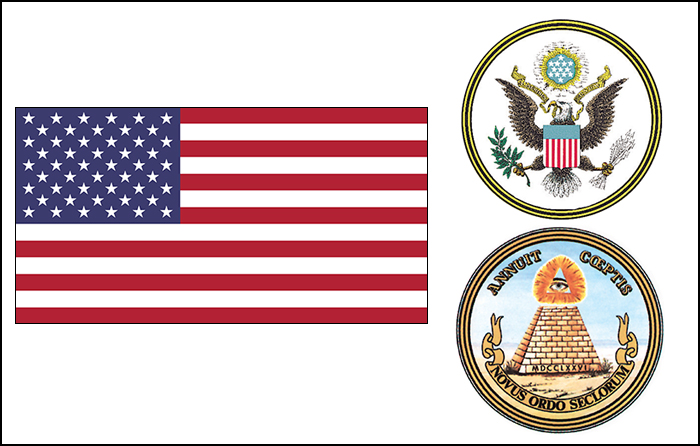
Economically, the United States is one of the world’s most highly developed and productive nations. No other country equals the United States in the production of goods and services. Its people enjoy one of the world’s highest standards of living.
Until the 1500’s, most of what is now the United States was thinly populated forests and prairies. Small groups of Native Americans lived scattered over the land between the Atlantic and Pacific. Inuit (formerly called Eskimos) inhabited what is now Alaska, and Polynesians lived in Hawaii. People in Europe saw in this vast “new world” a chance to build new and better lives. Small groups of Spaniards settled in what is now the southeastern and western United States in the 1500’s. People from England and some other European countries began settling along and near the East Coast during the 1600’s. In 1776, colonists in the East established an independent nation based on freedom and economic opportunity. Through the years, large numbers of Europeans continued to settle in the United States. People from almost every other part of the world also settled in the country. Except for Black Africans brought in as enslaved people, these immigrants came seeking the rights and the opportunities that had become part of the American way of life. As a result of this immigration, the United States today has one of the world’s most varied populations. It has been called “a nation of immigrants.”
Loading the player...United States national anthem
The vast space and resources of the land, the ideals of freedom and economic opportunity, and hard work by the people all helped build the United States into the economic giant it is today. The Americans—as the people are commonly called—also made major contributions in such fields as technology, science, and medicine. Americans developed the mass production system of manufacturing, the electric light bulb, the telephone, polio vaccine, and the transistor. They also created the skyscraper and such new art forms as jazz and musical comedy.
At times, the U.S. economy has run into difficulty. Even so, it remains one of the most productive systems ever developed. In some cases, groups of Americans have suffered socially and economically from discrimination. But the country’s laws have helped many people overcome discrimination and achieve better lives.
The nation
Political divisions.
The United States consists of 50 states and the District of Columbia. The District of Columbia is a piece of land set aside by the federal government for the nation’s capital, Washington, D.C. For a list of the states, see the table with this article titled Facts in brief about the states.
In area, population, and economic output, some of the states are comparable to many nations. The United States has a federal system of government, which gives the states many powers that national governments have in most other countries. For example, the states have broad control over public education and the establishment of civil and criminal laws.
Regions.
The states of the United States, excluding Alaska and Hawaii, are often divided into seven major regions. Each region is made up of states that have similarities in geography, climate, economy, traditions, and history. The regions are: (1) New England, (2) the Middle Atlantic States, (3) the Southern States, (4) the Midwestern States, (5) the Rocky Mountain States, (6) the Southwestern States, and (7) the Pacific Coast States. For a list of the states in each region, see the table titled Regions of the United States in this article.

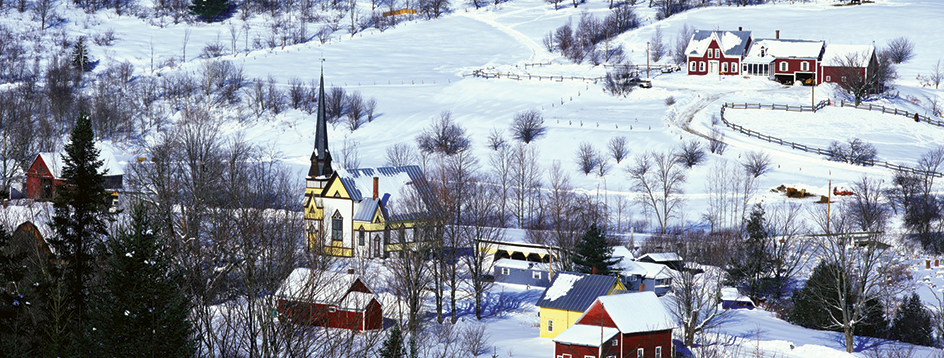
New England
is a small region in the northeast corner of the country that is known for charming rural villages, picturesque fishing harbors, and colorful autumn scenery. It was the nation’s first industrial center, and manufacturing is still a leading source of income. Industrial cities dot southern New England. Much of the land is too hilly or rocky to grow crops. But New England produces large amounts of dairy and poultry products and is famous for its maple syrup. Many tourists visit the region to see its historic sites—especially those from colonial times—and to enjoy its natural beauty.
Many New Englanders, especially in the rural north, are descendants of English Puritans who settled the region during the 1600’s. The more densely populated southern section of New England has people of many backgrounds, including African, English, French, German, Irish, and Italian. The southern section includes Boston, New England’s largest city by far.
The Middle Atlantic States Region
stretches inland from the Atlantic Ocean southwest of New England. Deepwater harbors help make the region a major center of international trade. The busiest harbor is at New York City, the largest city in the United States. Factories in and near such Middle Atlantic cities as—in order of size—New York City, Philadelphia, Newark, Pittsburgh, and Jersey City produce a wide variety of goods. Coal mining and related industries have historically been important economic activities in the western part of the Middle Atlantic States Region. Farms dot hillsides and fertile plains in various parts of the region. Forested mountains, sandy seashores, scenic lakes and rivers, historic sites, and big-city attractions draw many visitors to the region.
The Middle Atlantic States Region ranks as the nation’s most densely populated area. Its urban population includes people of varied European backgrounds, and large groups of people of Black African, Latin American, and Asian ancestry. Many of the region’s rural dwellers are of British descent.
The Southern States Region
is an area of rolling hills, mountains, and plains bordered by broad beaches along the Atlantic Ocean and the Gulf of Mexico. Until the mid-1900’s, the region’s economy was based heavily on agriculture. Such warm-weather crops as sugar cane, rice, tobacco, and—especially—cotton contributed greatly to the economy. Agriculture has retained importance in the South. However, an industrial boom that began in the mid-1900’s greatly increased manufacturing and improved the balance of the region’s economy. Tourists flock to coastal resorts in the South—especially in winter, when temperatures are usually relatively mild. Jacksonville is the largest city of the region. Charlotte, Louisville, Nashville, Washington, D.C., Memphis, Baltimore, and Raleigh rank next in size. Washington, D.C., is not part of a state, but it is in the Southern States Region. Loading the player...
Cajun fiddle music
Large numbers of Southerners are descended from early English, Irish, and Scottish immigrants. From the 1600’s to the 1800’s, many enslaved Africans were brought to the region to work on plantations. Today, large numbers of African Americans live in the Southern States Region. Many Southerners have a strong sense of regional loyalty and take pride in the South’s history and traditions.
The Midwestern States Region
is a vast area of generally flat land that covers much of the center of the United States. The Midwest is famous for its large stretches of fertile soil. Farms in the Midwestern States Region produce enormous quantities of corn, wheat, and other crops; and also dairy products and livestock. In addition, the Midwest has a number of large industrial cities. The cities include, in order of size, Chicago, Columbus, Indianapolis, Detroit, Milwaukee, and Kansas City. 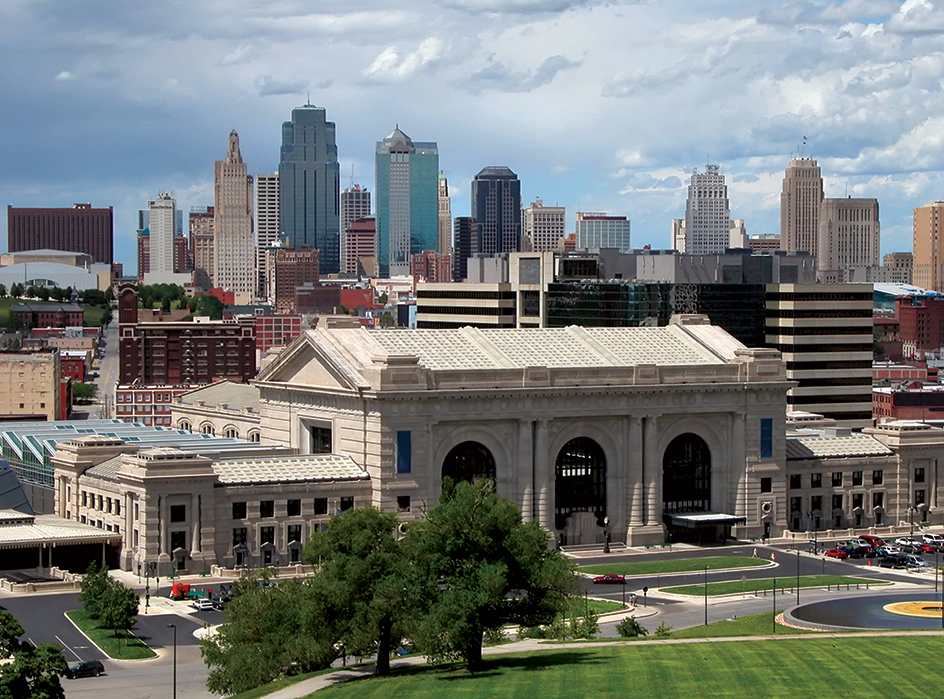
The Mississippi River system, the Great Lakes, and many railroads give the region an excellent transportation network. Lakes and rivers—some of which are set among rolling hills and rugged bluffs—provide numerous recreation areas.
The Midwestern States Region has a varied population. Its rural areas include large groups of descendants of settlers from England, Germany, Norway, Scotland, Sweden, and eastern and southern Europe. The region’s urban population includes many descendants of people who came from northern, southern, and eastern Europe. Other large ethnic groups in the cities include African Americans, Mexican Americans, and Asian Americans.
The Rocky Mountain States Region
lies west of the Midwest. It is named for the rugged, majestic Rocky Mountains, which cut through it. The region also has areas of deserts, plains, and plateaus. Although much of it is a thinly populated wilderness, some of its cities and towns are among the nation’s fastest-growing areas. Denver and Las Vegas rank as the region’s largest cities.
Rich deposits of gold, silver, and other metals first attracted settlers to the Rocky Mountain States Region. Mining remains an important economic activity, but such services as health care, hotels, and data processing are now the chief sources of income. Cattle and other livestock graze on dry, grassy ranges, and farmers grow a variety of crops in the Rocky Mountain States Region. Many tourists visit the region to enjoy its scenic beauty and numerous ski resorts.
The population of the Rocky Mountain States Region includes people of European descent, African Americans, Mexican Americans, and Native Americans. Mormons, whose ancestors founded a religious community in Utah in the 1800’s, form an important cultural group in the Rocky Mountain States Region.
The Southwestern States Region
spreads over a vast area that is sometimes called the “wide open spaces.” There, cattle graze on huge ranches, and vast fields of cotton and other crops soak up rays of blazing sunshine. However, petroleum has brought the region most of its wealth. The region has large deposits of petroleum and natural gas, as well as various other minerals. In the 1900’s, refineries and petrochemical factories led the way to industrialization in the Southwest. 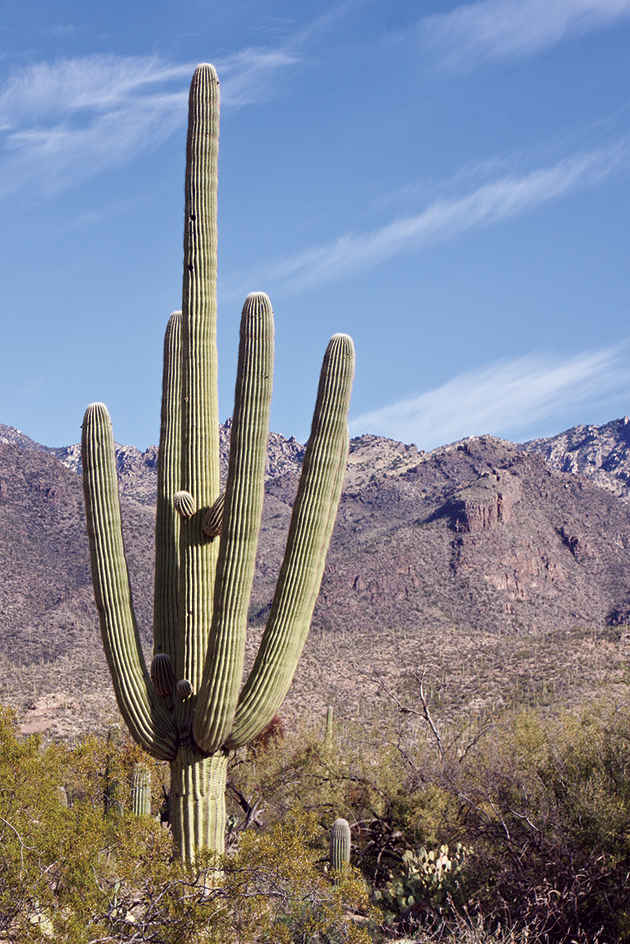
The industrialization has helped bring about much urban growth in the Southwestern States Region. The region includes many of the nation’s fastest-growing cities. Its largest cities are, in order of size, Houston, Phoenix, San Antonio, Dallas, Austin, Fort Worth, El Paso, and Tucson. The region also has many retirement communities. Tourist attractions in the Southwest include huge, unspoiled areas of incredible natural beauty, such as the Grand Canyon and the Painted Desert.
Many cultures come together in the Southwest. The population includes people of various European backgrounds, as well as African Americans, Mexican Americans, and Native Americans.
The Pacific Coast States Region,
which borders the Pacific Ocean, is known for its dense forests, rugged mountains, and dramatic ocean shore. The scenic beauty and relatively mild climate encourage an outdoor lifestyle enjoyed by both residents and tourists.
Fertile valleys in the Pacific Coast States Region produce a large part of the nation’s fruits, nuts, vegetables, and wine grapes. The region also has abundant timber, minerals, and fish. Much manufacturing takes place in its large cities, which include—in order of size—Los Angeles, San Diego, San Jose, San Francisco, and Seattle.
The discovery of gold and the opening of the Oregon Territory in the mid-1800’s brought a stream of settlers to the Pacific Coast. New residents, many drawn by the area’s booming computer industry, have continued to pour in ever since. Today, the population includes people of European, African American, and Mexican American ancestry. The region also has more people of Asian ancestry than any other part of the United States, and a large number of Native American people.
Outlying areas.
The United States has possession of various island territories in the Caribbean Sea and the Pacific Ocean. Some of them, such as Guam and the Virgin Islands, have a large degree of self-government. Puerto Rico, one of the areas, is a commonwealth associated with the United States that has been given wide powers of self-rule by the U.S. Congress. American Samoa, Guam, the Northern Mariana Islands, Puerto Rico, and the Virgin Islands each send to Congress a nonvoting delegate. See the table titled Main outlying areas of the United States in this article.
People
Population.
The U.S. Census Bureau reported that in 2020 the country had a population of 331,449,281. Figures from the 2010 census had put the population of the United States at 308,745,538.
White people make up about 61 percent of the country’s population. African Americans account for about 12 percent of the population. About 6 percent of the population is of Asian descent. Native Americans make up about 1 percent. Other groups, including those of mixed racial heritage, combine to make up the remaining 20 percent.
The U.S. population includes many Hispanic people, such as people of Mexican, Puerto Rican, or Cuban descent. Hispanic Americans represent a mixture of several ethnic backgrounds, including European, Native American, and African. Hispanic people make up about 20 percent of the U.S. population.
About 51 percent of the people in the United States are females. The United States has one of the highest life expectancies of any country—81 years for females and 76 years for males. Since 1945, the part of the U.S. population that is over 65 years old has increased from 8 percent to 17 percent. Improvements in medical care have been the main reason for the increase. The over-65 population of the United States will continue to grow at a rapid rate as advances in medicine continue and as the large numbers of people born during the “baby boom” grow older. The baby boom was a period of high birth rate that occurred in the United States from 1946 to 1964.
About 85 percent of the total population was born in the United States. The largest foreign-born groups are, in order of size, Mexicans, Chinese, Indians, Filipinos, Salvadorans, and Vietnamese. The population density in the United States varies widely from place to place. See the map in this section of the article for the density throughout the country. 
Ancestry.
The United States has one of the world’s most varied populations in terms of ancestry. The population includes descendants of people from almost every part of the world.
The first people to live in what is now the United States were Native Americans, Inuit, and Hawaiians. Native Americans and Inuit are descended from peoples who migrated to North America from Asia thousands of years ago. The ancestors of the Hawaiians were Polynesians who sailed to what is now Hawaii from other Pacific islands about 2,000 years ago. Loading the player...
Native American Pow-Wow
Most white Americans trace their ancestry to Europe. Some Spaniards settled in what is now the United States during the 1500’s. European settlement increased sharply during the 1600’s. At first, most of the settlers came from England. But America soon attracted many immigrants from other nations of northern and western Europe including France, Germany, Ireland, the Netherlands, and Scotland; and the Scandinavian lands of Denmark, Norway, and Sweden. Until the late 1800’s, northern and western Europe provided most of the immigrants. Then, large waves of people began arriving from southern and eastern European nations, including Austria-Hungary, Greece, Italy, Poland, and Russia.
Most Hispanic Americans are people who immigrated—or whose ancestors immigrated—to the United States from Latin America. A small percentage of them trace their ancestry directly back to Spain. Some have mainly Spanish ancestry. Others have mixed Spanish and Native American or Black African ancestry.
Most African Americans are descendants of Africans who were brought to the United States as enslaved people during the 1600’s, 1700’s, and 1800’s and forced to work on plantations. See Slavery (Slavery in the United States).
Since the 1800’s, the United States has attracted immigrants from Asia. Most Asian Americans trace their ancestry to China, India, Japan, Korea, the Philippines, or Vietnam. For more details on the flow of people into the United States through the years, see Immigration.
The United States has often been called a melting pot. This term refers to the idea that the country is a place where people from many lands have come together and formed a unified culture. Americans have many things in common. For example, the vast majority of them speak English, and people throughout the country dress similarly and eat many of the same kinds of foods. Public education, mass communication, and other influences have helped shape a common identity.
But in other ways, U.S. society is an example of cultural pluralism. That is, large numbers of its people have retained features of the cultures of their ancestors. Many Americans take special pride in their origins. They preserve traditions—and in some cases the languages—of their ancestors. In many cities, people of different national or ethnic origins live in separate neighborhoods, and shops and restaurants reflect their cultural heritages. Ethnic festivals, parades, and other events emphasize the nation’s cultural pluralism.
Language.
The United States has never had an official language, but English has always been the chief language spoken there. Immigrants from England, Scotland, and Ireland—who included the nation’s founders—spoke English. Many immigrants from other lands who spoke little or no English also came to the United States. They learned at least enough English to be able to communicate with other Americans. Their children learned English in school. The immigrants’ children generally spoke both English and their ethnic language, and in many families the immigrants’ grandchildren spoke only English.
Today, Spanish is the second most common language in the United States. The region that is now the Southwestern United States was colonized by Spain in the 1500’s. As a result, many people from that region speak Spanish. Since the 1950’s, many Spanish-speaking people have immigrated to the United States from Mexico, Cuba, and other places. Many of these people learned English. But others speak only Spanish. This is especially true in Spanish-speaking neighborhoods that developed in cities. Some people feel that special efforts should be made to provide education and other services in Spanish for people who speak only Spanish.
Many people believe every American should know English. They point out that it is difficult to get a job outside Spanish-speaking neighborhoods without a knowledge of English. They also argue that a language shared by everyone is an important unifying force for a country. Many states have passed laws declaring English to be their only official language. These laws provide that the government must offer its services in English, and need not do so in any other language. But in some places, public documents and signs are written in both English and Spanish.
Way of life
For census purposes, the United States is divided into urban areas and rural areas. An urban area, as defined by the U.S. Census Bureau, is a community with 5,000 or more people. A rural area is a community with fewer than 5,000 people.
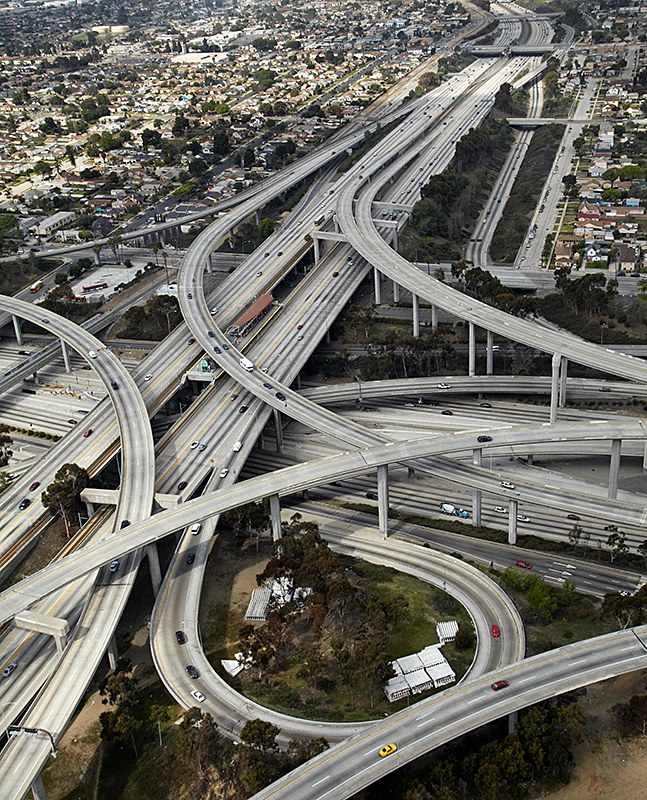
In 1790, the year of the first census, about 95 percent of the nation’s people lived in rural areas, and only about 5 percent were urban dwellers. Through the years, these percentages changed steadily and dramatically. Today, about 80 percent of all the people live in urban areas. Only about 20 percent live in rural areas.
Several factors contributed to the dramatic population shift from the countryside to urban areas. Through the years, Americans greatly improved agricultural methods and equipment. From the 1800’s onward, farm work has become more and more efficient, farm production has soared, and fewer and fewer people have been needed to work on the nation’s farms. At the same time, an industrial boom has created large numbers of new jobs in the nation’s urban areas. As a result of these economic changes, a steady flow of people from rural to urban areas has taken place. Also, large numbers of immigrants—many of whom had been farmers in their homelands—found jobs in cities and settled there when they reached the United States. In addition, the variety of job choices and recreational, educational, and cultural opportunities in cities attracted many rural people, especially the young. Large numbers of rural people left home to seek employment and excitement in cities.
Urban life.
Urban areas, which range from giant cities surrounded by suburbs to small towns, dot the U.S. landscape. Although the urban areas cover about 3 percent of the land, they are the home of about four-fifths of the people. New York City, with about 9 million people, is the largest U.S. city by far. Los Angeles has about 4 million people. About 2 3/4 million people live in Chicago. Seven other cities—Houston, Phoenix, Philadelphia, San Antonio, San Diego, Dallas, and San Jose—each have more than 1 million people.
Networks of suburbs surround many U.S. cities. The central cities and their suburbs form units called metropolitan areas. There are about 395 metropolitan areas in the United States. The three largest are, in order of size, the New York-Newark-Jersey City, Los Angeles-Long Beach-Anaheim, and Chicago-Naperville-Elgin areas. The New York area has about 20 million people, the Los Angeles area has just over 13 million people, and the Chicago area has about 9 1/2 million people.
For many years, the vast majority of the country’s urban population lived in the central cities. But during the mid-1900’s, suburban population soared throughout the United States, while central city growth slowed down or decreased. In 1970, for the first time, more Americans lived in suburbs than in central cities. 
The Northeast and Midwest have long had most of the nation’s largest urban areas. But during the 1900’s, other parts of the country experienced dramatic urban growth. Since the early 1900’s, many California urban communities—especially Los Angeles—have grown tremendously. Since the mid-1900’s, the populations of many more urban areas in the West, and in the South and Southwest, have soared. Such metropolitan areas as Atlanta, Dallas, Denver, Houston, and Phoenix grew rapidly. Large numbers of people were attracted to the West, South, and Southwest by jobs created by new industries. Also, many of the fastest-growing communities have warm, sunny climates, which helped attract many of the newcomers. Parts of the South, Southwest, and West are sometimes called the Sun Belt because they have such climates.

Urban economies provide jobs for a great variety of workers, including office and factory workers, bankers, doctors, fire fighters, medical personnel, police officers, teachers, trash collectors, and construction and transportation workers. Urban life also has many other positive features. Because urban areas have large populations, they generally offer a wide variety of specialized services and shops. Urban dwellers can take advantage of an assortment of restaurants, recreation facilities, and places of entertainment. Because of such facilities as art galleries, museums, libraries, theaters, and concert halls, many cities are important cultural centers. These and other features make urban areas exciting and interesting places to live for many people.
The people of most U.S. urban areas represent a variety of ethnic backgrounds. Most cities include neighborhoods in which almost all the people belong to the same ethnic or nationality group. The people of large urban areas are also divided economically. Urban society includes extremely wealthy and extremely poor people, and a huge middle class. The wealthy live in luxurious apartments or condominiums, or in large, comfortable single-family houses. Middle-class housing also includes apartments, condominiums, and single-family houses. In general, the housing of the middle class is comfortable, though not as luxurious as that of the wealthy. In contrast, large numbers of urban poor people live in substandard housing. They rent crowded, small apartments or rundown single-family houses. 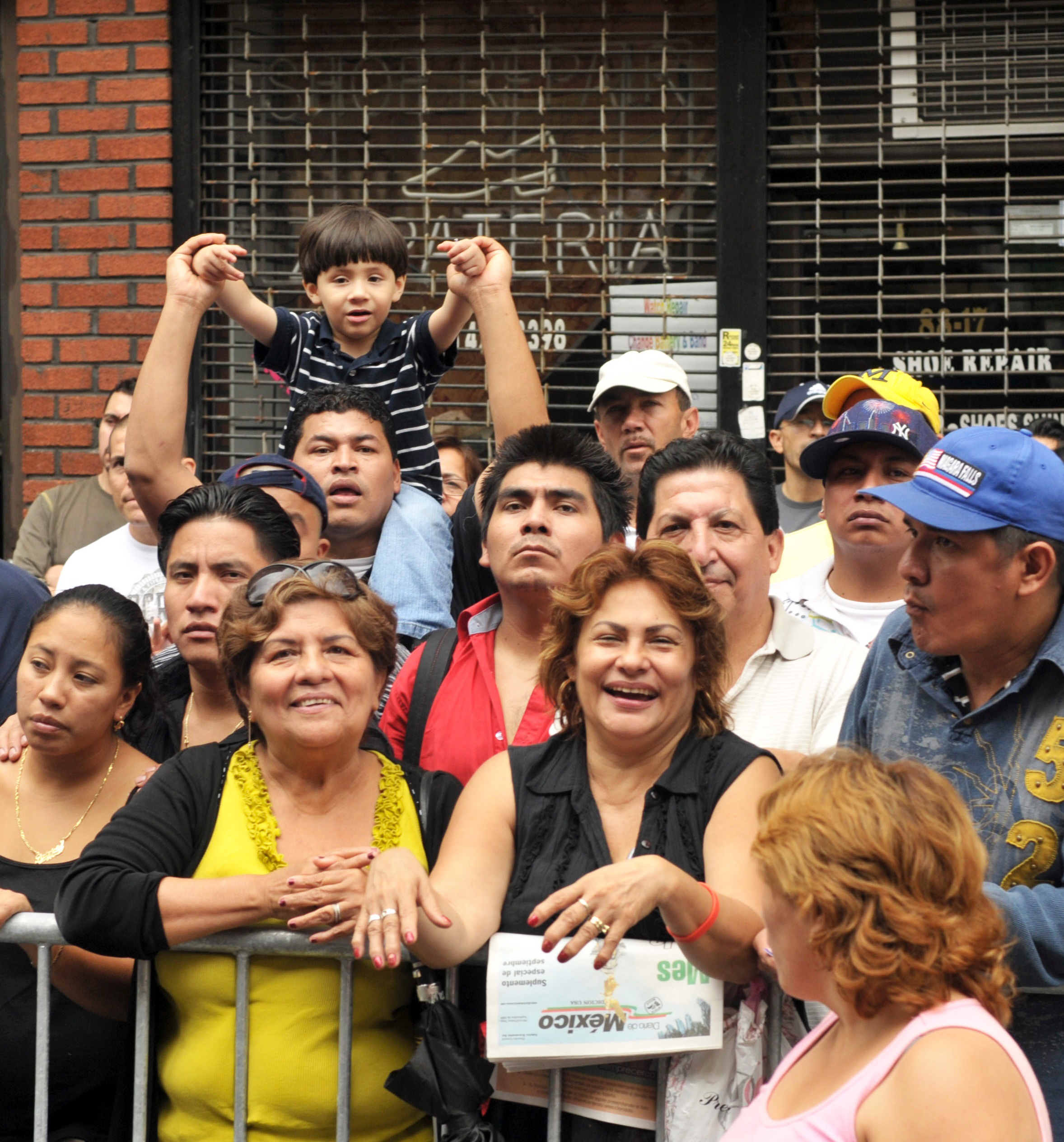
In addition to substandard housing, urban areas have a number of other unpleasant features. Such features include high crime rates, racial and ethnic friction, noisy surroundings, pollution, and traffic jams. See City (City challenges).
Rural life.
About 97 percent of all the land of the United States is classified as rural. But much of the rural land is uninhabited or only thinly inhabited. About a fifth of all Americans live in rural areas.
Farms provide the economic basis of the nation’s rural areas. But only about 8 percent of the country’s rural people work on farms. Many other rural people own or work in businesses related to agriculture, such as grain and feed stores and warehouses. Mining and related activities and light industries also employ many rural people. Still other rural Americans work as teachers, police officers, salesclerks, or in other occupations. Many farmers hold other jobs for part of the year to add to their incomes. 
American farmers of today lead vastly different lives from those of their grandparents. Machines have eliminated much backbreaking farm work. Farmers use machines to help them plow, plant seeds, harvest crops, and deliver their products to market. Many farms have conveyor systems so that the farmer no longer has to shovel feed to farm animals. Milking machines make morning and evening chores easier. In the home, farm families may have all the comforts and conveniences of city people. In the 1900’s, the automobile, telephone, radio, television, and computer brought U.S. farm families into close contact with the rest of the world. 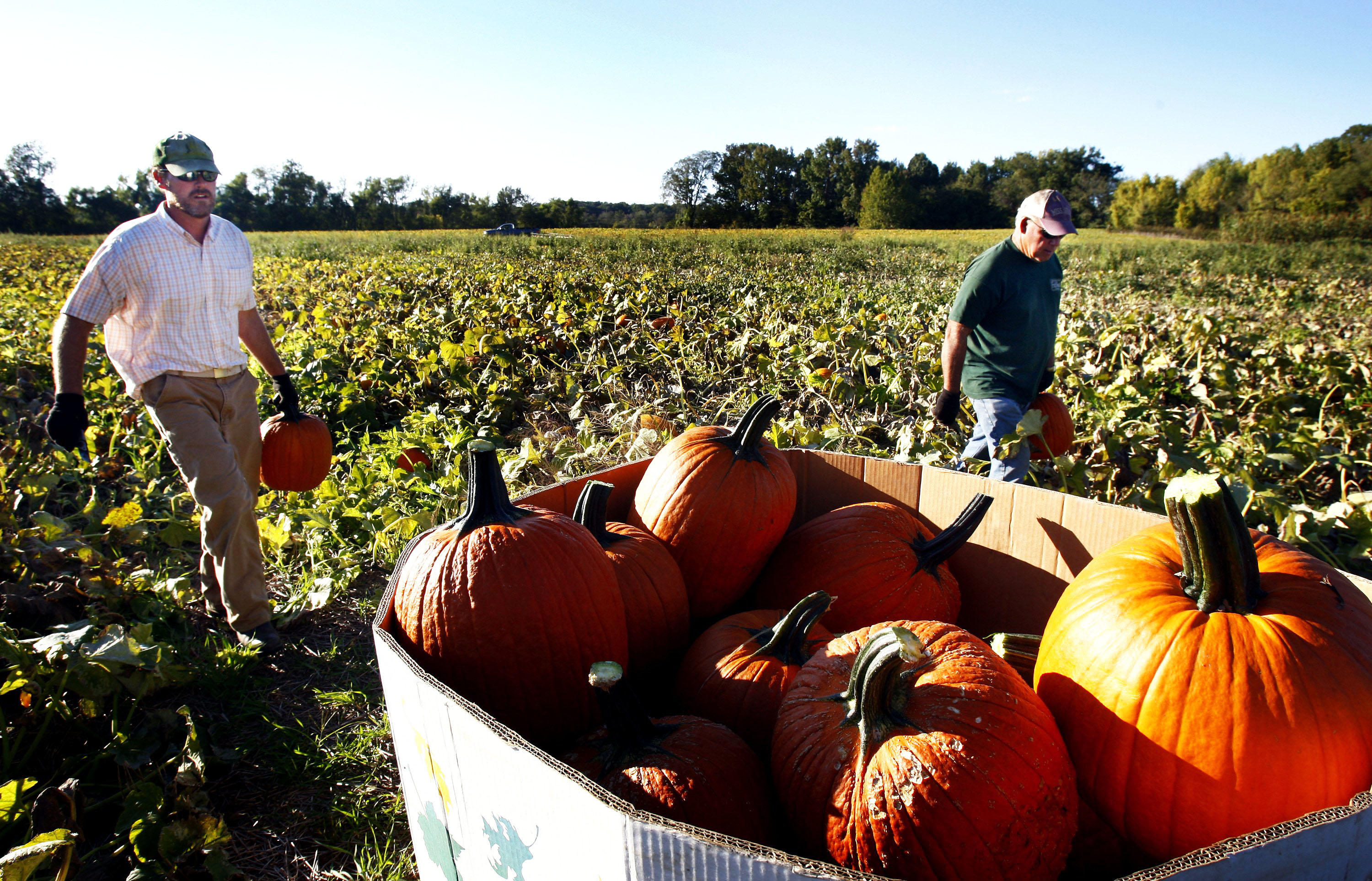
The steady decline in the percentage of the country’s rural population has slowed since 1970. Although many people continued to move away from rural areas, others chose to move into rural towns and farm communities. Many of the newcomers wanted to escape the overcrowding, pollution, crime, and other problems that are part of life in urban areas and to take advantage of benefits of country living. Rural areas have lower crime rates and less pollution than urban areas. They are also far less noisy and crowded.
Because of their small populations, rural communities collect less tax revenues than urban communities do, and they generally cannot provide the variety of services that urban areas can. For example, rural communities have cultural and recreational facilities that are more limited than those available in urban areas. For many rural Americans, social life centers around family gatherings, church and school activities, special interest clubs, and such events as state and county fairs.
Rural areas generally have less diversified economies than urban areas. Because there are fewer jobs and a smaller variety of jobs to choose from, rural communities may experience more widespread economic hardships than urban communities. A single economic downturn—a drop in farm prices, for example, or the closing of a mine—can cause economic hardship for an entire rural area.
The nation’s rural areas, like its urban areas, have wealthy, middle class, and poor people. For the most part, however, the gaps between economic classes are not as large in rural areas as in urban areas. Most rural Americans live in single-family houses. The majority of the houses are comfortable and in good condition. But some people, including many who live in parts of Appalachia—in the eastern United States—and other pockets of rural poverty, have rundown houses and enjoy few luxuries. See Farm and farming; Ranching.
Education
has been an important factor in the economic development of the United States and in the achievement of a high standard of living for most Americans. It has also contributed to the enjoyment of life for many people. Americans are among the best-educated people in the world. Schools, libraries, museums, and other educational institutions in the country provide learning opportunities for people of all ages.
Schools.
During the early history of the United States, most schools were privately owned. Church groups owned and operated many of them. In the early 1800’s, the idea of free public schools began to gain widespread support in the country. State and local governments took the responsibility for establishing public school systems. By 1918, every state had laws requiring children to attend school until they reached a certain age or completed a certain grade. Today, a majority of the nation’s elementary and high schools, and many of its institutions of higher learning, are public schools. The rest are private schools run by religious organizations or private groups.
Many American children begin their schooling before enrolling in first grade. A number of children aged 3 and 4 attend nursery schools, and a large majority of all 5-year-olds attend kindergarten. Nearly all U.S. children complete elementary school, and a majority of them graduate from high school. Many high school graduates go on to colleges or universities.
Adult education is an important part of the school system in the United States. Millions of adults take courses at universities, colleges, vocational schools, recreation centers, or other institutions. Many adults continue their schooling to improve their job skills or to get training for a new job. Others attend classes simply to develop new hobbies or to find out more about topics that interest them. A growing number of part-time and full-time college and university students are men and women who have held jobs or raised families and are returning to school to get a degree.
Public schools in the United States are supported mainly by taxation. Private schools get their operating funds chiefly from tuition and contributions of private citizens. The nation’s schools, like its private businesses, have always had to deal with financial problems. Rapidly rising material and salary costs have increased the financial problems of the schools. Some public and private schools have cut back on programs and reduced their faculties to try to keep expenses in line with revenues. Colleges and universities have sharply increased their tuition and fee charges.
Schools in the United States face a number of other problems. Many schools, particularly in large cities, have rundown buildings, inadequate supplies, and overcrowded conditions. A far higher percentage of young people in these areas drop out of school than in other areas. Some people claim that schools in their areas fail to provide students with the skills to obtain and hold jobs. Schools with large numbers of students from other countries face the problem of educating some children who speak little or no English. See Education.
Libraries
provide the American people with access to books, periodicals, pamphlets, and other printed matter. In addition, many libraries offer compact discs, DVD’s, and other multimedia materials; internet access; research services; lectures; and educational exhibits.
There are thousands of public libraries in the United States. They range from one-room libraries in small towns to huge city libraries and their branches. There are also thousands of university and college libraries in the United States, as well as thousands of libraries in elementary schools and high schools.
The nation’s library system also includes large numbers of private research libraries and special libraries with collections limited to certain fields of knowledge. In addition, many government agencies and businesses operate their own libraries. Three of the government’s many libraries are considered national libraries because of their large and varied collections and because of the many services they provide. They are the Library of Congress, the National Agricultural Library of the Department of Agriculture, and the National Library of Medicine of the Department of Health and Human Services. See Library.
Museums.
There are thousands of museums in the United States. They include museums of art, history, natural history, and science. In addition, a number of historic houses and villages are classed as museums. The collections of many of the nation’s museums are devoted to a single topic of interest, such as the history of baseball or railroads. Some museums have huge collections of items from many parts of the world. Others feature exhibits of local interest. In addition to exhibits, many U.S. museums offer classes, lectures, films, field trips, and other educational services. The most famous museums in the United States include the Metropolitan Museum of Art in New York City, the Kenneth C. Griffin Museum of Science and Industry in Chicago, and the Smithsonian Institution in Washington, D.C. See Museum.
Religion.
About 70 percent of all the American people are members of an organized religious group. Among them, about 40 percent are Protestants, and about 20 percent are Roman Catholics. Buddhists, Hindus, Jews, Mormons, Muslims, and members of Eastern Orthodox Churches each make up a small percentage of the population. Roman Catholics make up the largest single religious denomination in the United States. About 70 million Americans are Roman Catholics. The country’s largest Protestant groups are, in order of size, Baptists, Methodists, Pentecostals, Lutherans, and Presbyterians.

Religion has played an important role in the history of the United States. Many people came to the American Colonies to escape religious persecution in other lands. The early colonists included Puritans in New England, Roman Catholics in Maryland, and Quakers in Pennsylvania. The early Americans made religious freedom one of the country’s basic laws. The First Amendment to the Constitution of the United States, which was adopted in 1791, guarantees every American freedom of religion. It also provides that no religious group be given official recognition as a state church. These provisions were intended to prevent persecution of religious minorities and the favoring of one church over another. Religious freedom was one of the reasons immigrants continued to flock to the United States through the years.
Although all religious groups in the United States enjoy freedom, Christian traditions have had a stronger influence on American life than those of any other faith. For example, most offices, factories, and other places of employment are closed on Sunday, the Sabbath of most Christians. The influence of Christianity results from the fact that a majority of the people are Christians.
Throughout the country’s history, religion has influenced everyday life in a number of ways. For example, in colonial America many religious rules were enforced by local governments (see Colonial life in America (Religion)). Some of the laws that prohibited activities on Sunday still exist (see Sunday).
Today, religion has relatively less influence in the everyday lives of most Americans. But churches and other religious organizations continue to play important roles in American life. Their chief functions are to provide moral guidance and places for worship. However, religious groups also operate many elementary and secondary schools, colleges, universities, hospitals, and nursing homes. They provide aid for refugees, the poor, the elderly, orphans, and other persons in need. Social gatherings are held at many churches. Some religious groups take active roles in discussing such issues as birth control and rights for minorities and women.
Recreation.
Most Americans have a great deal of leisure time, and they spend it in a variety of ways. They pursue hobbies, take part in sports, attend sporting and cultural events, watch movies and television, listen to music, read books and magazines, and browse internet content. They enjoy trips to museums, beaches, parks, playgrounds, and zoos. They take weekend and vacation trips, eat at restaurants, go on picnics, and entertain friends at home. These and other activities contribute to the richness and diversity of American life.
Sports rank as a leading American pastime. Millions of Americans enjoy watching such sports events as automobile races, horse races, and baseball, basketball, football, hockey, and soccer games—either in person or on television. Many Americans, especially children and other young people, play baseball, basketball, football, and soccer. People of most ages participate in such sports as bicycle riding, boating, bowling, fishing, golf, hiking, hunting, running, skiing, softball, swimming, and tennis.
Motion pictures, plays, concerts, operas, and dance performances attract large audiences in the United States. Americans find entertainment at home, as well. Almost all American homes have a television set. Many homes also have personal computers and electronic gaming systems. The use of smartphones became nearly universal in the 2010’s and 2020’s.

Hobbies occupy much of the leisure time of many Americans. Large numbers of people enjoy raising flower or vegetable gardens or indoor plants. Other popular leisure time activities include baking and cooking, photography, and playing a musical instrument. Such crafts hobbies as knitting, pottery making, and woodworking are also popular.
Most Americans spend part of their leisure time traveling. Many take annual vacations, as well as occasional one-day excursions or weekend trips. Some have vacation homes near lakes or seashores, in the mountains, or in other recreation areas. Others own motor homes or trailers, which provide living and sleeping quarters during trips. Some people enjoy camping in tents. Others prefer to stay in hotels or motels while on trips.
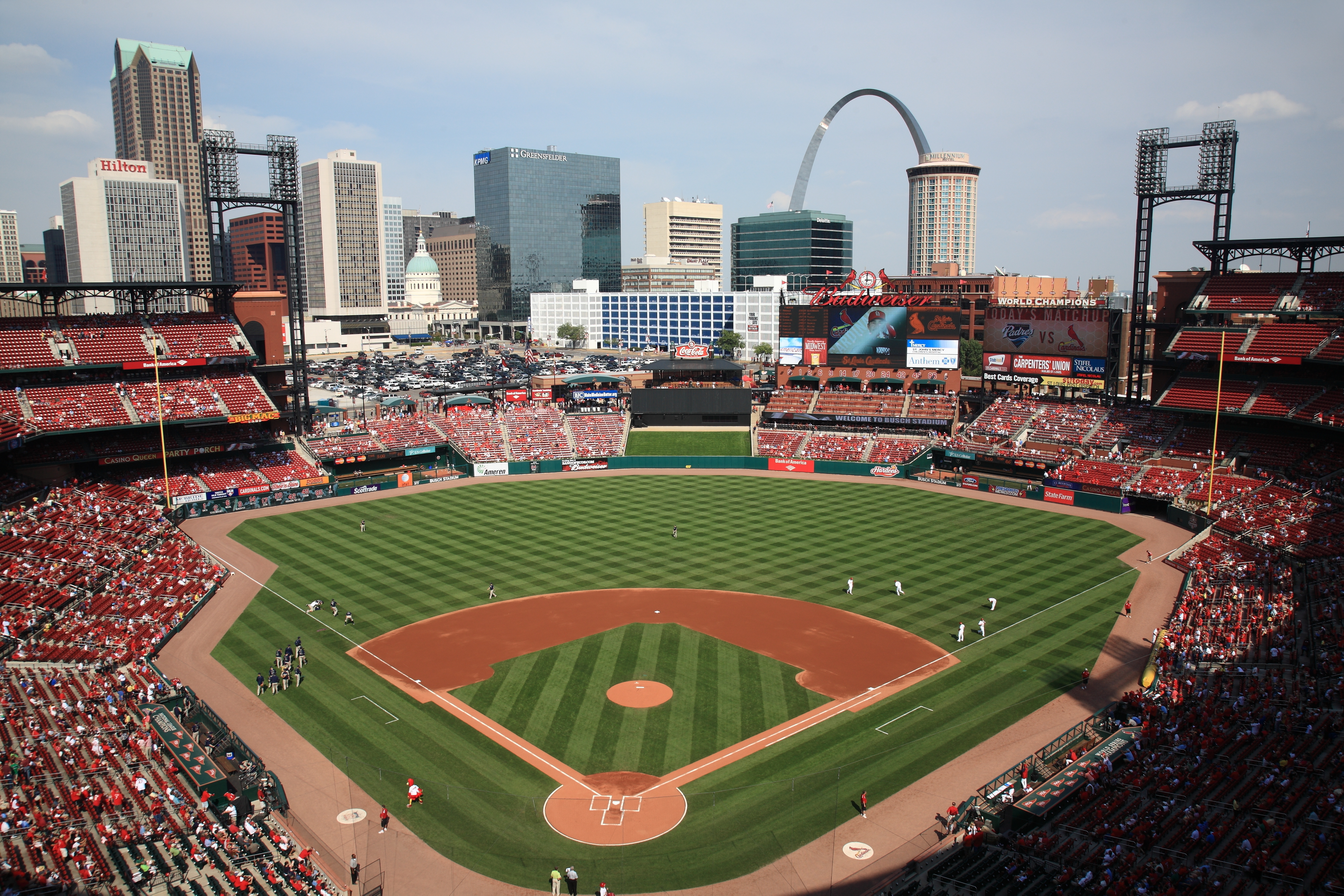
Food.
Americans eat a wide variety of foods. A typical dinner consists of meat and potatoes, plus a lettuce salad or a vegetable, and sometimes rolls or bread. Favorite dinner meats include beef steaks, ground beef dishes, chicken, ham, and turkey. Fish, shellfish, and such dishes as pizza and spaghetti also serve as main courses.
For lunch, many Americans eat a sandwich, such as a hamburger or a hot dog. Other favorite sandwiches include those made with meat or sliced sausage, cheese, peanut butter, and chicken or tuna salad.
Some Americans enjoy a hearty breakfast of eggs or pancakes served with bacon or sausage. Others prefer a light breakfast of toast or a pastry, or cereal with milk and fruit. Orange juice accompanies many breakfasts.
Cake, cookies, pie, and ice cream are eaten as desserts and snacks. Other snack foods include chocolate candy, potato or corn chips, and such fruits as bananas, apples, oranges, and grapes.
Beverages are drunk with meals and also at other times for refreshment. Consumption of soft drinks, especially cola, exceeds that of any other beverage. Varieties of bottled water also are popular. Americans also drink much coffee, milk, and beer, and smaller amounts of fruit juices, tea, and wine.
Americans eat out often. Fast-food restaurants have wide popularity. They offer a limited variety of foods, all of which are served within a few minutes. Common fast-food items include hamburgers and other sandwiches, fried chicken, and French fried potatoes. Many Americans also enjoy the cooking of other countries. Chinese, French, Italian, and Mexican restaurants have long been popular. Since the mid-1900’s, Americans have increasingly enjoyed the cuisines of India, Japan, Thailand, the Middle East, and many other areas.
Some regions of the United States have distinctive food specialties. For information on such foods, see Hawaii (People); Louisiana (People); Pennsylvania Dutch.
The arts
European colonists arrived in America during the early 1600’s, bringing European art traditions with them. But within a few years, colonists were building houses that probably rank as the first major American works of art. During the 1700’s, American craftworkers began to produce outstanding examples of furniture, sculpture, and silverwork. By the mid-1700’s, colonial painters were creating excellent portraits.
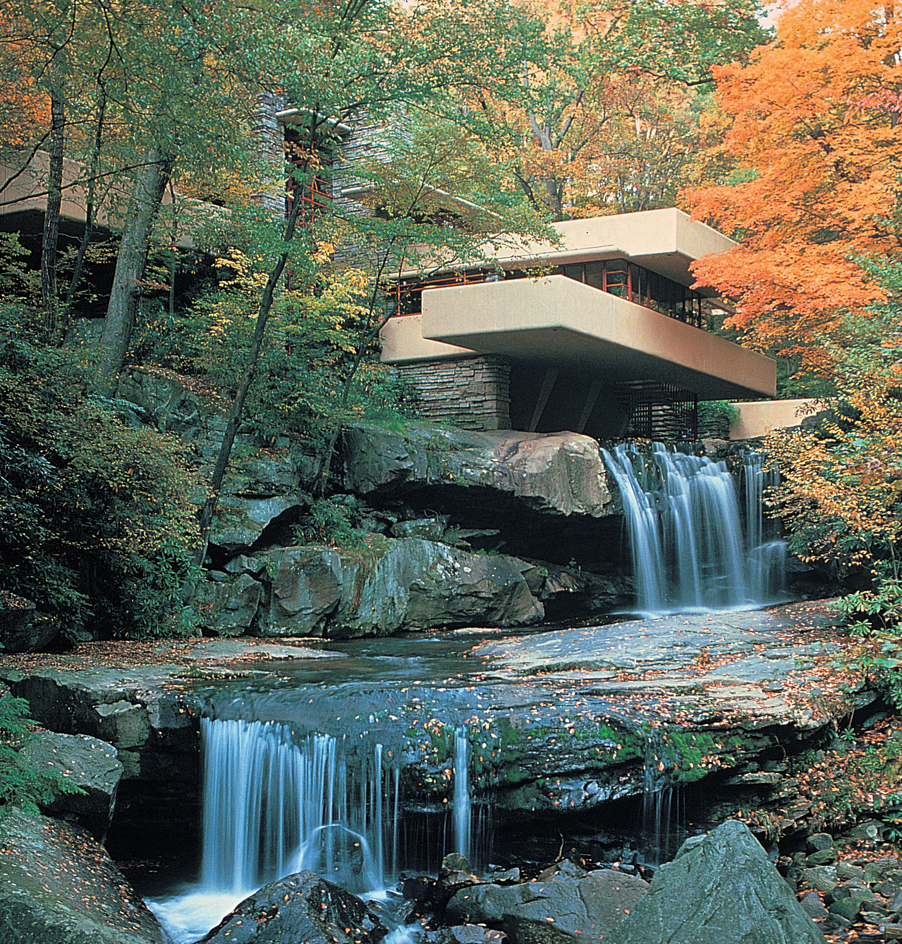
The first important American literature appeared in the early 1800’s with the works of such authors as Washington Irving and James Fenimore Cooper. During the late 1800’s, American architects began designing skyscrapers that revolutionized urban architecture throughout the world. Two uniquely American art forms, jazz and musical comedy, developed during the late 1800’s and early 1900’s. In the early 1900’s, the United States gained international leadership in the new art forms of motion pictures and modern dancing.

Today, American architects, authors, composers, filmmakers, painters, and sculptors have achieved worldwide recognition and influence. Many of them have shown a keen interest in developing new styles, new ways of expressing themselves, and even new forms of art.
The land
The United States, excluding Alaska and Hawaii, can be divided into seven major land regions. The regions are: (1) the Appalachian Highlands; (2) the Coastal Lowlands; (3) the Interior Plains; (4) the Ozark-Ouachita Highlands; (5) the Rocky Mountains; (6) the Western Plateaus, Basins, and Ranges; and (7) the Pacific Ranges and Lowlands. For a discussion of the land regions of Alaska and the islands of Hawaii, see the articles on those states.
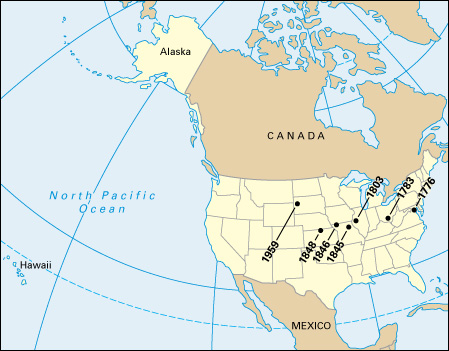
The Appalachian Highlands
extend from the northern tip of Maine southwestward to Alabama. This rugged region has many mountain ranges.
The White Mountains and the Green Mountains of northern New England are old mountains, worn down but craggy in some places. Southern New England consists mostly of hilly land. New England’s chief river is the Connecticut. The Adirondack Upland of northern New York includes mountains and many beautiful lakes. 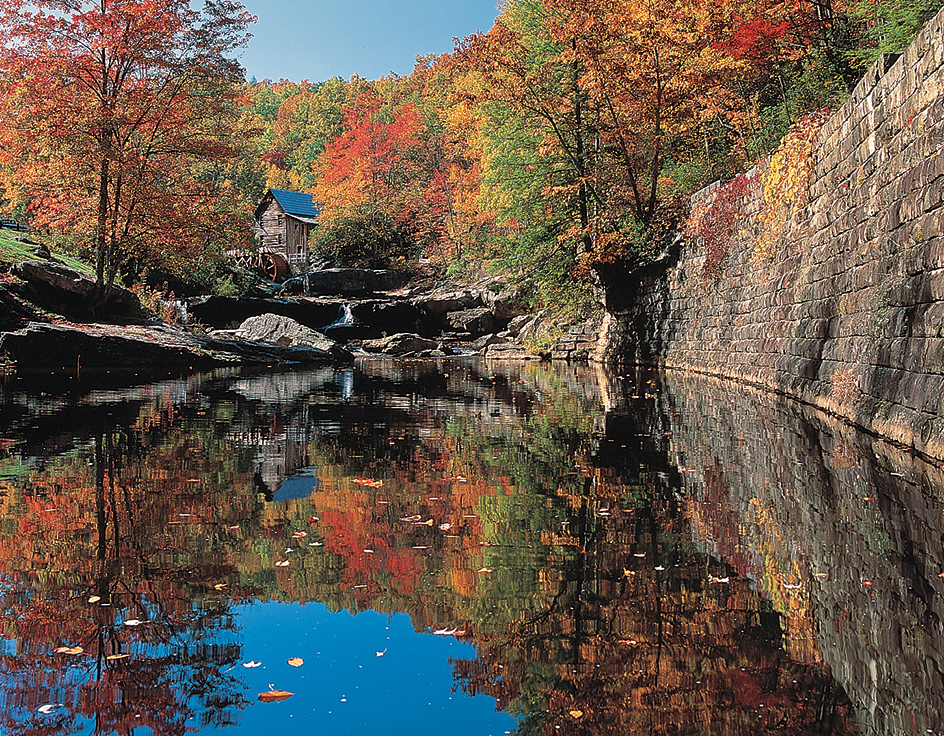
From central New York southward, the Appalachian Highlands has three main subdivisions. They are, from east to west: the Blue Ridge Mountains Area, the Ridge and Valley Region, and the Appalachian Plateau.
The Blue Ridge Mountains Area consists of some of the oldest mountains in the country. The Blue Ridge Mountains themselves are a narrow chain that stretches from southeastern Pennsylvania to northeastern Georgia. The Great Smoky Mountains of Tennessee and North Carolina are also part of this area. The Hudson Highlands of New York and New Jersey form a northern extension of the area. Several mighty rivers, including the Delaware, Hudson, Potomac, and Susquehanna, cut through the mountains to form water gaps. The gaps provide low, level land for highways and railroads.
The Ridge and Valley Region consists of the Great Valley in the east and a series of alternating ridges and valleys in the west. The rolling Great Valley is actually a series of valleys, including the Cumberland, Lebanon, and Lehigh valleys in Pennsylvania; the Shenandoah Valley in Virginia; the Valley of East Tennessee; the Rome Valley in Georgia; and the Great Valley of Alabama. The region has some forests, but other wooded areas have been cleared to take advantage of fertile soil and relatively level land for farming. About 50 dams on the Tennessee River and its branches in the southern Great Valley provide flood control and hydroelectric power.
The Appalachian Plateau extends from New York to Alabama. Glaciers covered the northern plateau during the most recent ice age, which ended about 11,500 years ago, and carved out natural features, including the Finger Lakes in New York. Deep, narrow river valleys cut through the plateau in some areas, creating steep, rugged terrain. Deposits of coal, iron ore, oil, and other minerals lie beneath the surface, and many people in the region work in mining. Parts of the region have good farmland. But thin, rocky soil covers much of the plateau, and the steep hillsides are badly eroded.
The Coastal Lowlands
extend from southeastern Maine, across the eastern and southern United States, to eastern Texas. Forests of hickory, oak, pine, and other trees are common throughout the lowlands. The region has three subdivisions: (1) the Piedmont, (2) the Atlantic Coastal Plain, and (3) the Gulf Coastal Plain. 
The Piedmont
is a slightly elevated rolling plain that separates the Blue Ridge Mountains from the Atlantic Coastal Plain. It stretches from southern New York to Alabama. The eastern boundary of the Piedmont is called the Fall Line. Rivers that reach the Fall Line tumble down from the Piedmont to the lower coastal plains in a series of falls and rapids. In the early days of settlement of the eastern United States, boats traveling inland on coastal rivers stopped at the Fall Line and unloaded their cargoes. The rapids prevented the boats from traveling farther. They also provided water power for early industries. As a result, many cities grew up along the Fall Line. Tobacco is a leading agricultural product of the Piedmont, and the region also has many orchards and dairy farms. See Piedmont Region; Fall line.
The Atlantic Coastal Plain
extends eastward from the Piedmont to the Atlantic Ocean. It ranges from a narrow strip of land in New England to a broad belt that covers much of North and South Carolina, Georgia, and Florida. In colonial times, the broad southern part of the plain encouraged the development of huge plantations for growing cotton. Cotton is still grown there. Other farm products include vegetables, citrus fruits, peanuts, and tobacco. In New England, where the plain narrows to a width of about 10 miles (16 kilometers) in some places, farming has always been less important. Many New Englanders turned to manufacturing, fishing, or shipping instead of farming.
Numerous rivers cross the plain and flow into the Atlantic Ocean. They include the Delaware, Hudson, James, Potomac, Roanoke, Savannah, and Susquehanna. Bays cut deeply into the plain in some areas, creating excellent natural harbors. They include Cape Cod Bay, Boston Bay, Chesapeake Bay, Delaware Bay, and Long Island Sound.
Many resort areas flourish around the beautiful sandy beaches and offshore islands that line much of the Atlantic shore from New England to Florida. In some inland regions, swamps and other wetlands cover large areas, where trees and grasses rise up from shallow waters and tangled vines and roots form masses of vegetation.
The Gulf Coastal Plain
borders the Gulf of Mexico from Florida to southern Texas. Numerous rivers—including the Alabama, Mississippi, Rio Grande, and Trinity—cross the plain and flow into the Gulf. The Mississippi, which originates in the Interior Plains to the north, is the most important of these rivers. Barges carrying cargoes from many parts of the country travel along the river. Soil deposited along the banks of the Mississippi and other rivers in the Gulf Coastal Plain creates fertile farmland. The plain also has belts of hilly forests and grazing land, and large deposits of petroleum and natural gas lie beneath it and in the offshore Gulf waters. The Gulf Coastal Plain has many sandy beaches, swamps, bays, and offshore islands.
The Interior Plains
occupy a huge expanse of land that stretches from the Appalachian Highlands in the east to the Rocky Mountains in the west. Glaciers covered much of the region during the Ice Age. They stripped the topsoil from parts of Michigan, Minnesota, and Wisconsin and carved out thousands of lakes. Today, much of this area is heavily forested. Farther south—in parts of Illinois, Indiana, Iowa, and Ohio—the glaciers flattened the land and deposited rich soil ideal for growing crops. The plains slope gradually upward from east to west and get progressively drier. 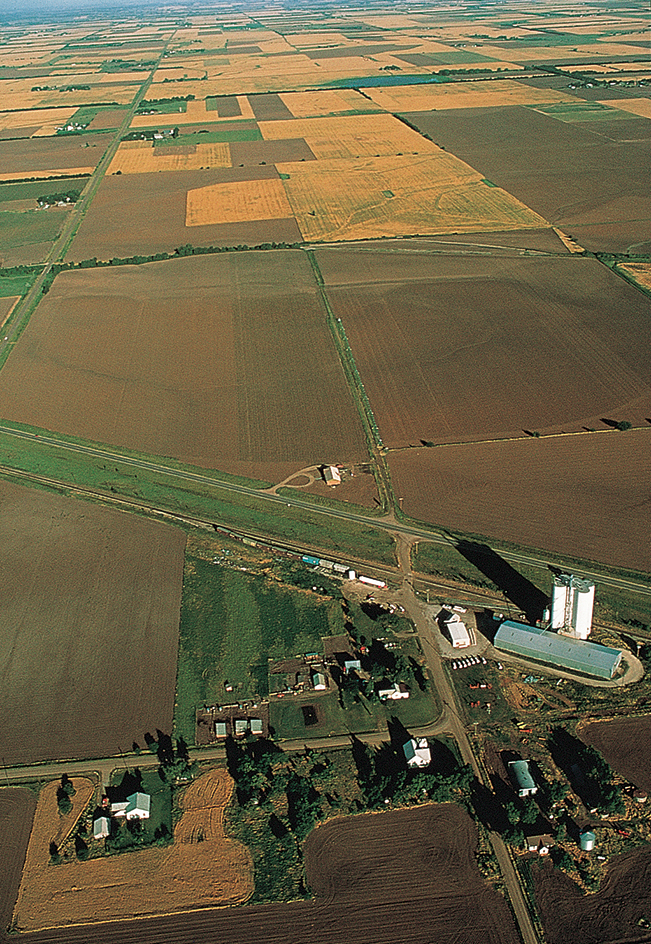
The western part of the region, called the Great Plains, has vast grasslands where livestock graze. It also has large areas of fertile soil that yield corn, wheat, and other crops. Few trees grow on the Great Plains. Some rugged hills, including the Black Hills of South Dakota and Wyoming, rise up out of the plains.
Deposits of iron ore and coal provide raw materials for many manufacturing industries in the eastern part of the Interior Plains. Important deposits of petroleum and metal ores lie in the western part.
Glaciers carved out the five Great Lakes in the Interior Plains. The lakes—Erie, Huron, Michigan, Ontario, and Superior—are the largest group of freshwater lakes in the world. The lakes provide a vital transportation route for shipping the agricultural and industrial products of the Interior Plains. The Mississippi River is the region’s other great waterway. The Mississippi and its many branches, including the Missouri and Ohio rivers, form a river system that reaches into all parts of the Interior Plains.
The Ozark-Ouachita Highlands
rise up between the Interior Plains and Coastal Lowlands. The highlands form a scenic landscape in southern Missouri, northwest Arkansas, and eastern Oklahoma. The region is named for the Ozark Plateau and the Ouachita << WAHSH ih tah >> Mountains. Rivers and streams have cut deep gorges through the rugged highland terrain. The highlands include forested hills, artificial lakes, and many underground caves and gushing springs. Much of the region has poor soil for farming but fertile land lies along the river valleys. Deposits of coal, iron ore, and other minerals are valuable natural resources of the highlands.
The Rocky Mountains
form the largest mountain system in North America. They extend from northern Alaska, through Canada and the western United States to northern New Mexico. Many peaks of the Rockies are more than 14,000 feet (4,270 meters) high. The Continental Divide, also called the Great Divide, passes through the mountains. It is an imaginary line that separates streams that flow into the Pacific Ocean from those that flow into the Atlantic, the Gulf of Mexico, and the Arctic Ocean. Many important rivers, including the Colorado, Missouri, and Rio Grande, begin in the Rockies.
Forests cover the lower mountain slopes. The timber line marks the elevation above which trees cannot grow. Grasses, mosses, and lichens grow above the line. Bighorn sheep, elk, deer, bears, mountain lions, and other animals live in the mountains. Lakes and streams add to the region’s spectacular beauty.
Lumbering and mining are important industries in the Rockies. The mountains are a storehouse of such metals as copper, gold, lead, silver, and zinc. The region also has large deposits of oil and natural gas. Mountain meadows provide grazing land for beef and dairy cattle, and valleys are used for growing crops.
For many years, the Rockies formed a major barrier to transportation across the United States. In the 1860’s, the nation’s first transcontinental rail line was built, passing through the Rocky Mountain region at the Wyoming Basin. Today, other railroads and highways cut through tunnels and passes in the mountains, and airplanes fly over the mountains.
The Western Plateaus, Basins, and Ranges
lie west of the Rocky Mountains. This region extends from Washington south to the Mexican border. It is the driest part of the United States. Parts of it are deserts with little plant life. But the region has some forested mountains, and some fertile areas where rivers provide irrigation water necessary for growing crops. In other areas, livestock graze on huge stretches of dry land. 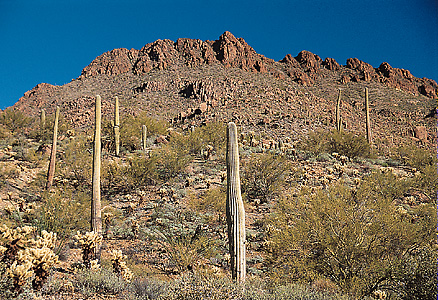
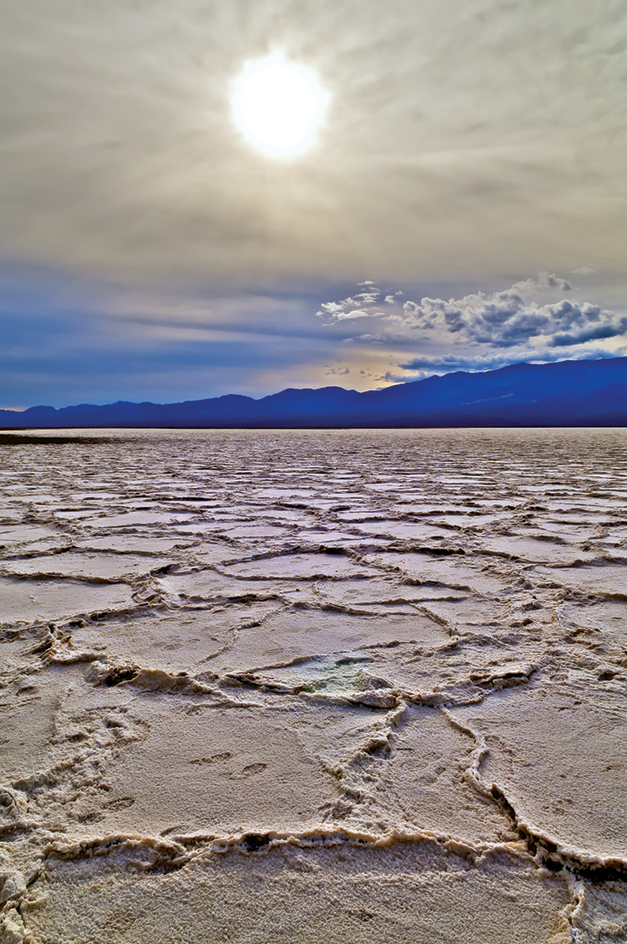
The Columbia Plateau occupies the northernmost part of the region. It has fertile volcanic soil, formed by lava that flowed out of giant cracks in the earth thousands of years ago. The Colorado Plateau lies in the southern part of the region. It has some of the nation’s most unusual landforms, including natural bridges and arches of solid rock and huge, flat-topped rock formations. The plateau’s spectacular river gorges, including the Grand Canyon, rank among the world’s great natural wonders.
The Basin and Range part of the region is a vast area of mountains and desert lowlands between the Columbia and Colorado plateaus. It includes Death Valley in California. Part of Death Valley lies 282 feet (86 meters) below sea level and is the lowest place in the United States. The Great Basin is an area within the larger Basin and Range area. Great Salt Lake is the largest of many shallow, salty lakes in the Great Basin. Bathers cannot sink in Great Salt Lake because the high salt content provides great buoyancy, enabling swimmers to float with ease. Near the lake is the Great Salt Lake Desert, which includes a large, hard, flat bed of salt.
The Pacific Ranges and Lowlands
stretch across western Washington and Oregon and most of California. The region’s eastern boundary is formed by the Cascade Mountains in the north and by the Sierra Nevada in the south. Volcanic activity formed the Cascades. Two of the Cascades—Lassen Peak in California and Mount St. Helens in Washington—are active volcanoes. Some of the range’s highest peaks have glaciers and permanent snowfields. Evergreen forests cover the lower slopes and provide the raw materials for lumber and paper products industries. The Sierra Nevada are granite mountains, dotted with lakes and waterfalls.
Broad, fertile valleys lie west of the Cascade and Sierra Nevada mountains. They include the Puget Sound Lowland of Washington, the Willamette << wih LAM iht >> Valley of Oregon, and the Central Valley of California. Valley farms produce large amounts of fruits and vegetables.
West of the valleys, the Coast Ranges line the Pacific shore. In many places, they rise up abruptly from the ocean, creating craggy walls of rock. In other areas, the mountains lie behind sandy coastal plains. Deep bays that jut into the coast include Puget Sound, Columbia River Bay, San Francisco Bay, and San Diego Bay. 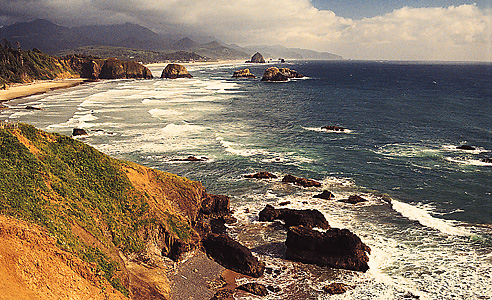
The San Andreas Fault runs through the Coast Ranges in California. It is a break in Earth’s rocky outer shell, along which movements of the rock have taken place. Giant redwood trees grow on the mountains in northern California. Set among the Coast Ranges are a number of rich agricultural valleys that produce much of the nation’s wine grapes and other fruit, and lettuce.
Climate
The climate of the United States varies greatly from place to place. Average annual temperatures range from 12 °F (–11 °C) in Utqiagvik (formerly Barrow), Alaska, to 78 °F (26 °C) in Key West, Florida. The highest temperature ever recorded in the world was 134 °F (57 °C). It was registered at Death Valley on July 10, 1913. The country’s lowest recorded temperature was –80 °F (–62 °C). It was registered at Prospect Creek, Alaska, near Utqiagvik, on Jan. 23, 1971.
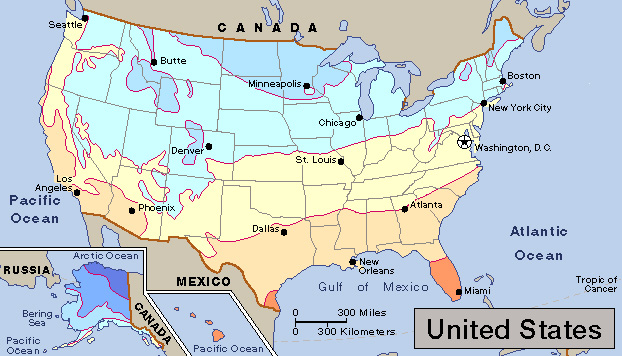
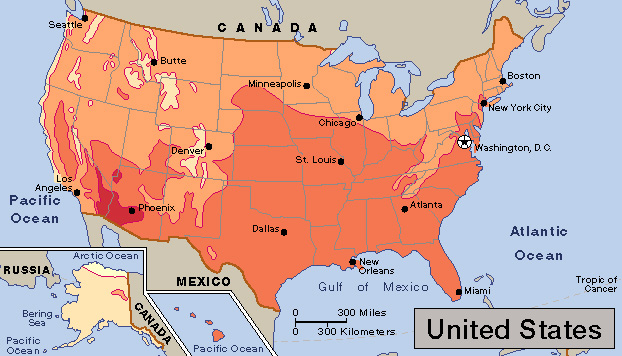

Precipitation varies from a yearly average of about 2 inches (5 centimeters) at Death Valley to about 460 inches (1,170 centimeters) at Mount Waialeale << wy `ah` lay AH lay >> in Hawaii. In general, however, most parts of the United States have seasonal changes in temperature and moderate precipitation. The Midwest, the Middle Atlantic States, and New England experience warm summers and cold, snowy winters. In the South, summers are long and hot, and winters are mild. Along the Pacific Coast, and in some other areas near large bodies of water, the climate is relatively mild all year. Mountains also affect the climate. In the West, for example, the mountainous areas are cooler and wetter than the neighboring plains and plateaus. Parts of the West and Southwest have a desert climate.
The moderate climate in much of the United States has encouraged widespread population settlement. It has also helped make possible the production of a great variety of agricultural goods.
See North America (Climate). See also the section on Climate in each state article.
Economy
The United States ranks first in the world in the total value of its economic production. The nation’s gross domestic product (GDP)—the value of all the goods and services produced within a country in a year—was about $23 trillion in 2021. This was larger than the gross domestic product of any other country in the world.

The United States economy is based largely on a free enterprise system. In such a system, individuals and companies are free to make their own economic decisions. Individuals and companies own the raw materials, equipment, factories, and other items necessary for production, and they decide how best to use them in order to earn a profit.
Even though the U.S. economy is based on free enterprise, the government has placed regulations on economic practices through the years. It has passed antitrust laws, which are designed to keep one company or a few firms from controlling entire industries. Such control, called a monopoly, does away with competition and enables controlling companies to charge high prices and reduce the quality of goods. Government regulations help protect consumers from unsafe merchandise. They also help protect workers from unsafe working conditions and unreasonably low wages. The government has also enacted regulations designed to reduce environmental pollution.
Some people argue that the government interferes in the economy too much, while others say it should do more. In spite of involvement by the government, the United States still has one of the least regulated economies in the world. See Capitalism; Monopoly and competition.
Despite its overall strength, the United States economy faces problems from time to time. The problems include recessions (mild business slumps), depressions (severe business slumps), and inflation (rising prices). See Depression; Great Depression; Recession; Inflation.
Natural resources.
The United States has a vast array of natural resources including a moderate climate, fertile soils, and plentiful minerals, water, forests, and fish. However, the United States uses more than it has and must import some raw materials to provide for the needs of its citizens.
Minerals.
The United States has large deposits of coal, iron ore, natural gas, and petroleum, which are vital to the country’s industrial strength. Its many other important mined products include copper, gold, lead, limestone, phosphates, silver, sulfur, and zinc. To meet its needs, however, the United States must import additional amounts of iron ore, petroleum, and other materials.
Soils.
The United States has vast expanses of fertile soil that is well suited to growing crops. The most fertile soils include the dark soils of the Interior Plains and the alluvial (water-deposited) soils along the lower Mississippi River Valley and other smaller river valleys. Rich, windblown soil called loess covers parts of eastern Washington and the southern Interior Plains.
Water.
Lakes, rivers, and underground deposits supply water for households, farms, and industries in the United States. The nation uses about 320 billion gallons (1,210 billion liters) of water daily. Households use only about 10 percent of this total. The vast majority of the rest is used to irrigate farms and to operate steam power plants.
Forests
cover about a third of the United States, and they yield many valuable products. Much of the nation’s lumber comes from forests in the Pacific Northwest. Forests in the South supply lumber, wood pulp—which is used to make paper—and nearly all the pitch, rosin, turpentine, and wood tar produced in the United States. The Appalachian Mountains and parts of the Great Lakes area have fine hardwood forests. Hickory, maple, oak, and other hardwood trees cut from these forests provide quality woods for the manufacture of furniture.
Fish.
Americans who fish for a living catch millions of tons of fish and shellfish each year. The greatest quantities are taken from the Pacific Ocean, which supplies cod, crabs, halibut, pollock, salmon, tuna, and other fish. Leading catches from the Gulf of Mexico include crabs, menhaden, oysters, and shrimp. The Atlantic Ocean yields flounder, herring, menhaden, and other fish; and such shellfish as clams, crabs, lobsters, oysters, and scallops.
Service industries
account for the largest portion of the U.S. gross domestic product and employ a majority of the country’s workers. This industry group includes a wide variety of businesses that provide services rather than producing goods.
Finance, insurance, and real estate
play an important part in the nation’s economy. Banks finance much of the economic activity in the United States by making loans to both individuals and businesses. American banks loan billions of dollars annually. Most of the loans go to individuals to help finance the purchase of automobiles, houses, or other major items. Bank loans to businesses provide an important source of money for capital expansion—the construction of new factories and the purchase of new equipment. As a business expands, it hires more workers. These workers, in turn, produce more goods and services. In this way, the nation’s level of employment and its economic output both increase.
Other important types of financial institutions include commodity and security exchanges. Commodities are basic goods, such as grains and precious metals. Securities are certificates of investment, such as stocks and bonds. The prices of commodities and securities are determined by the buying and selling that takes place at exchanges. The New York Stock Exchange is the nation’s largest security exchange. The CME Group in Chicago is one of the world’s largest commodity exchanges.
The United States has the world’s largest private insurance industry. The country has thousands of insurance companies. Real estate is important to the economy because of the large sums of money involved in the buying and selling of property.
Community, business, and personal services
employ more people than the businesses that make up any other U.S. industry. Businesses within this group include engineering companies, information technology companies, law firms, private health care, private research laboratories, and repair shops.
Trade, restaurants, and hotels
play major roles in the American economy. Wholesale trade, which includes international trade, takes place when a buyer purchases goods directly from a producer. The goods may then be sold to other businesses for resale to consumers. Retail trade involves selling products to the final consumer. Automobile dealerships, department stores, and grocery stores are examples of retail trade establishments. Restaurants and hotels greatly benefit from the tens of millions of foreign tourists who visit the United States annually.
International trade provides markets for surplus agricultural goods and many raw materials and manufactured goods produced in the United States. The nation imports goods that it lacks entirely or that producers do not supply in sufficient quantities. It also imports goods produced by foreign companies that compete with U.S. firms. Traditionally, the value of U.S. exports has exceeded, or been about the same as, the value of U.S. imports. But since the mid-1960’s, the value of imports has usually been much higher than the value of exports.
Important U.S. exports include (1) machinery and transportation equipment, such as aircraft, computers, electric power equipment, industrial machinery, and motor vehicles and parts; (2) chemical elements and compounds, including plastic materials; (3) manufactured articles, especially scientific measuring equipment; (4) fuels and lubricants; (5) basic manufactures, such as metals and paper; and (6) food crops and live animals.
The leading U.S. imports are (1) machinery and transportation equipment, such as automobiles and auto parts, office machines, and telecommunications equipment; (2) manufactured articles, such as clothing, shoes, and toys; (3) basic manufactures, such as iron, steel, and other metals, and paper and newsprint; (4) chemical products; (5) fuels and lubricants, especially petroleum; and (6) food crops and live animals.
Canada, China, Japan, and Mexico are the country’s chief trading partners. Other major trading partners include Brazil, France, Germany, South Korea, Taiwan, and the United Kingdom. The North American Free Trade Agreement (NAFTA), which took effect in 1994, eliminated trade barriers among Mexico, Canada, and the United States. In 2020, the United States-Mexico-Canada Agreement (USMCA) updated and replaced NAFTA while maintaining the largely tariff-free trade zone that NAFTA had established.
Government services
play a major role in the economy. Federal, state, and local governments employ many U.S. workers. Many government employees are directly involved in making public policies. Others—including police officers, postal workers, teachers, and trash collectors—provide public services.
Federal, state, and local governments buy about a third of all the goods and services produced in the nation. These purchases range from paper clips to office buildings. The federal government is the nation’s largest single buyer of goods and services. Its agencies, including the military, buy billions of dollars worth of equipment from private companies. In addition, federal grants finance much of the nation’s research activity. State governments spend most of their income on education, health care and hospitals, highways, and public welfare. Local governments spend about a third of their income on education, and less for police and fire protection, hospitals, streets, sanitation and sewerage, and parks.
In addition to its roles as an employer and purchaser of goods and services, government influences the economy by providing income to certain groups of people. For example, the federal government makes Social Security payments to retired people and people with disabilities. Federal, state, and local governments provide welfare assistance to the needy. Such government programs are the only source of income for some Americans.
Transportation and communication
are also important to the economy. More information on transportation and communication appears later in this section.
Manufacturing
is an important economic activity in the United States both in terms of employment and the gross domestic product. The United States is a leading producer of manufactured goods. Factories in the United States turn out a tremendous variety of producer goods, such as sheet metal and printing presses; and consumer goods, such as cars, clothing, and TV sets. The leading categories of U.S. products are, in order of value, chemicals, food products, transportation equipment, fabricated metal products, machinery, computer and electronic products, petroleum and coal products, plastics and rubber products, primary metal products, beverage and tobacco products, paper products, nonmetallic mineral products, wood products, and electrical equipment. 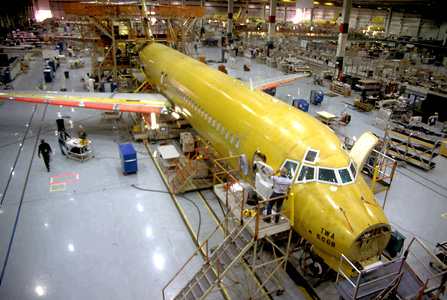
The Midwest and Northeast have long been major U.S. centers of manufacturing. Since the mid-1900’s, the country’s fastest-growing manufacturing areas have been on the West Coast, in the Southwest, and in the South. Today, California ranks first among the states in the value of its manufactured goods, followed by Texas, Ohio, Indiana, Illinois, Pennsylvania, North Carolina, and Michigan. Manufacturers in California produce aircraft, aerospace equipment, chemicals, computers and electronic components, food products, and many other goods.
Midwestern factories turn out much of the nation’s iron and steel, automobiles, and other heavy industrial products. The Northeast has many chemical manufacturers, food-processing companies, and manufacturers of electronic equipment. Petroleum refineries and petrochemical industries account for much of the manufacturing activity in Texas and other states bordering the Gulf of Mexico. Dallas-Fort Worth, Los Angeles, Phoenix, Seattle, and Wichita are important centers for the manufacture of aircraft and related equipment.
Through the years, Americans have developed manufacturing processes that have greatly increased productivity. During the early 1900’s, United States automobile firms introduced the moving assembly line and identical interchangeable parts for cars. These innovations led to mass production, in which large numbers of goods could be produced in less time and at a lower cost than ever before. Beginning in the mid-1900’s, U.S. industries turned increasingly to automation—the use of machines that operate with little human help. American inventors and engineers developed computers to bring automation to an even higher level. Today, computers operate machines, handle accounting, and perform many other important functions in industries. See Manufacturing.
Construction
consists of activities involved in building and maintaining residences, business offices, storage warehouses, and other structures. This industry employs such workers as architects, engineers, contractors, bricklayers, carpenters, electricians, plumbers, roofers, ironworkers, and plasterers.
Agriculture
accounts for only a small part of the U.S. gross domestic product. Yet, the United States is a world leader in agriculture production. The country’s farms turn out as much food as the nation needs, with enough left over to export food to other countries. Food exports account for much of U.S. farm income. 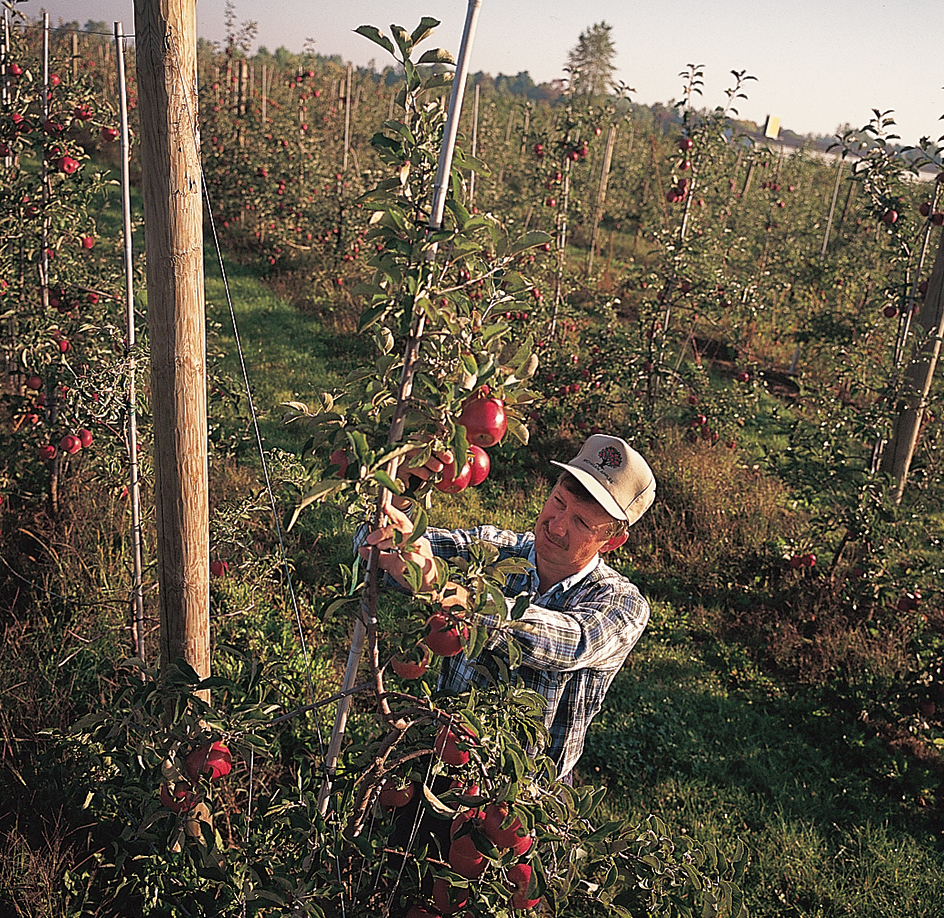
Beef cattle and corn rank as the most valuable products of American farms. Millions of beef cattle are raised on huge ranches in the midwestern and western United States. Corn is mostly grown in the Midwest. Other leading farm products, in order of value, include soybeans, dairy products, broilers (young, tender chickens), hogs, greenhouse and nursery products, wheat, chicken eggs, and hay. United States farms also produce large amounts of almonds, apples, cotton, grapes, lettuce, potatoes, rice, strawberries, tomatoes, and turkeys.
Farmers throughout the country raise dairy cattle for milk and other products. Much of the dairy production is concentrated in a belt that extends from Minnesota through New York. Midwestern states account for much of the nation’s hog and soybean production. The nation’s chief wheat-growing region stretches across the Great Plains. The South raises most of the broilers. California, Texas, and a few other states in the South and Southwest raise almost all the country’s cotton. Farms in various areas also produce poultry, eggs, and crops of fruits, vegetables, nuts, and grains.
The United States has played a major role in the modernization of agriculture. During the 1800’s, American inventors developed the first successful harvesting machine and steel plow. United States scientists have contributed to the development of improved plant varieties and livestock breeds, as well as agricultural chemicals for fertilizer and pest control.
The use of modern farm machinery and agricultural methods has helped make U.S. farms the most efficient in the world. But it has also contributed to rapidly rising production costs. Many farmers who have been unable to meet these rising costs have been forced to quit farming and sell their land. Since 1925, the number of farms in the United States has decreased from about 6,500,000 to about 2,000,000. At the same time, average farm size increased from about 143 acres (58 hectares) to about 445 acres (180 hectares). Some of the largest farms in the United States are owned by corporations. But more than 90 percent of all the farms are owned by individuals or partnerships made up of members of farm families. See Agriculture; Farm and farming.
Mining.
The United States ranks among the leading countries in the value of its mine production. The chief mined products of the United States are, in order of value, petroleum, natural gas, and coal. The United States ranks as a leading producer of coal, natural gas, and petroleum. Most coal deposits lie in the Interior Plains and the Appalachian Highlands. Major deposits of petroleum and natural gas occur in Alaska, California, Louisiana, New Mexico, Oklahoma, and Texas. Other important mined products include cement, clays, copper, gold, granite, iron ore, lead, lime, limestone, molybdenum, phosphate rock, salt, sand and gravel, silver, soda ash, sulfur, traprock, and zinc.
Although mining accounts for a small share of the total U.S. economic output, it has been a key to the growth of other parts of the economy. Coal and iron ore, for example, are needed to make steel. Steel, in turn, is used to make automobiles, buildings, bridges, and many other goods. Coal is also a fuel for electric power plants. Refineries turn petroleum into gasoline; fuel oil for heating and industrial power; and petrochemicals used in plastics, paint, drugs, fertilizers, and synthetic fabrics. Limestone, granite, and traprock are crushed for use in construction materials. Sand and gravel are also used in construction. Sulfur and phosphates are used to make fertilizer. See Mining. 
Energy sources.
The farms, factories, households, and motor vehicles of the United States consume vast amounts of energy annually. Various sources are used to generate the energy. Petroleum provides about 35 percent. It is the source of most of the energy used to power motor vehicles, and it heats millions of houses and factories. Natural gas generates about 30 percent of the energy used, and coal about 10 percent. Many industries use natural gas for heat and power, and millions of households burn it for heat, cooking, and drying laundry. Coal’s major uses are in the production of electric power and steel. The electric power lights buildings and powers factory and farm machinery. Nuclear power plants generate less than 10 percent of the country’s energy. In the 2000’s, hydroelectric plants, solar installations, and wind farms accounted for increasing amounts of the country’s electricity production.
Since the mid-1900’s, the cost of energy—especially the petroleum portion—has risen dramatically. The rising cost became a major contributor to inflation in the United States and other countries. For more details, see Energy supply.
Transportation.
A sprawling transportation network spreads out over the United States. The country has millions of miles or kilometers of streets, roads, and highways. The federal interstate highway system provides a network of about 48,000 miles (77,000 kilometers) of freeways. The United States has an average of about 80 motor vehicles for every 100 people. Americans use automobiles for most of their personal travel. Trucks carry about 45 percent of the freight in the United States. See Road; Automobile; Truck. 
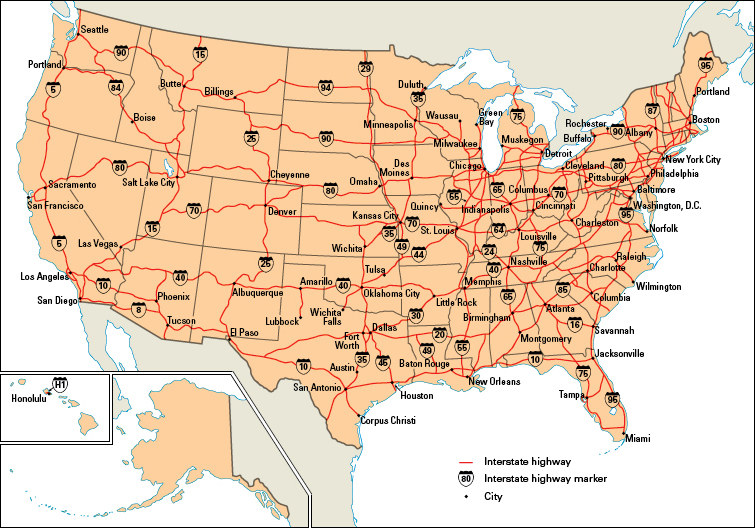
Railroads handle about 25 percent of the freight. But they account for less than 1 percent of all passenger traffic. See Railroad.
Airlines handle about 10 percent of all U.S. passenger traffic, but less than one-half of 1 percent of the freight traffic. Five of the 10 busiest airports in the world are in the United States. See Airport; Aviation.
About 10 percent of the freight traffic within the United States travels on waterways. The Mississippi River handles about 50 percent of this freight. Ships and barges traveling on the Mississippi and its branches, including the Arkansas, Missouri, and Ohio rivers, can reach deep into the country’s interior. The Great Lakes form the nation’s other major inland waterway. The St. Lawrence Seaway links the lakes with the Atlantic Ocean. See Inland waterway.
The United States has many major ports. A port west of New Orleans ranks as the nation’s busiest port, followed by the ports of Houston and New York City. See Port.
The nation has a vast network of pipelines that carries crude oil, petroleum products, and natural gas. Pipelines account for about 20 percent of the total freight handled in the United States. See Pipeline.
Communication.
Private corporations operate the publishing and broadcasting industries in the United States. The First Amendment of the Constitution guarantees freedom of the press and speech. These guarantees allow newspapers and broadcasters to operate without government censorship. Laws prohibit the publishing or broadcasting of libelous, obscene, and treasonous materials. But, for the most part, the government interferes little in the operation of the communication industry. The free exchange of ideas and information is a vital part of the democratic heritage of the United States.
Publishers in the United States issue about 1,200 daily newspapers, which have a total circulation of about 25 million copies. The nation also has thousands of weekly and semiweekly newspapers. The newspapers provide information on local, national, and international events. Many also include such special features as opinion columns, articles on health and fashion, and comic strips and crossword puzzles.
In the United States, most newspapers serve a local region. But The Wall Street Journal, USA Today, and The New York Times circulate to most of the country. Most newspapers today also have websites. Readers can access news content through personal computers, smartphones, and other devices. Since the 1990’s, the widespread availability of news online has led to declining print readership and the closures of hundreds of newspapers. See Newspaper.
There are thousands of radio and television stations and also thousands of cable and satellite TV systems in the United States. Radio, television, and the internet provide the public with entertainment, news, and public interest programs. In the United States, both national networks and local stations produce and broadcast programs. Almost every household has at least one TV set and radio. Many households subscribe to cable or satellite television or internet-based entertainment services. Approximately 90 percent of households have access to the internet. See Internet; Radio; Television.
